Manchester Museum
This EarthCache has been placed with the kind permission of Manchester Museum. Please check the museum website for opening hours.
Manchester Museum is a museum displaying works of archaeology, anthropology and natural history and is owned by the University of Manchester.
Located on Oxford Road in Manchester, the museum houses many items covering natural and human history. This EarthCache will take you on a short tour of the Geological exhibits in the museum.
Due to improvements and redevelopments, the entrance to the museum has been temporarily moved to the fossils gallery.
Starting in the planets section, in the balcony overlooking the shop, there are some samples of rock to the left on a display board. Questions 1 & 2 relate to this area

These are small parts of moonrock and meteors (a solid object moving in interplanetary space, of a size considerably smaller than an asteroid and considerably larger than an atom) that have been collected and are mounted as a touch display that you can feel as you look out of the solar system. According to the museum website, this is the only place on Earth you can touch Mars, the Moon and an asteroid all at the same time!
Moon Rock.
The sample of the Moon is a lunar meteorite that was found in North West Africa. NWA 5000 is a feldspathic breccia (rock consisting of angular fragments of stones cemented by finer calcareous material) and represents part of the Moon’s earliest crust.
Mars Rock
Shergottites are pieces of the crustal mantle of the planet Mars that were blown into orbit by an enormous meteorite impact hitting the red planet. After this impact, this meteorite travelled through space before it was eventually brought down to Earth by the Earth's gravitational pull.
They are named after the Shergotty meteorite, which fell at Sherghati, India in 1865. Shergottites are igneous rocks (rock formed through the cooling and solidification of magma or lava) of mafic (a silicate mineral or igneous rock that is rich in magnesium and iron) to ultramafic (igneous rock with a very low silica content and rich in minerals such as hypersthene, augite, and olivine) lithology. The shergottites appear to have crystallised as recently as 180 million years ago, which is a surprisingly young age considering how ancient the majority of the surface of Mars appears to be, and the small size of Mars itself. Because of this, some have advocated the idea that the shergottites are much older than this. The 3-million-year-old crater Mojave, 58.5 km in diameter and the youngest crater of its size on the planet, has been identified as a potential source of these meteorites.
Chelyabinsk Meteorite
When the Chelyabinsk asteroid exploded over Russia in 2013 much of it fragmented into pea-sized pieces of debris. Based on its entry direction and speed of 19 kilometres/second, the Chelyabinsk meteor apparently originated in the asteroid belt between Mars and Jupiter. It was probably a fragmented asteroid. The touchable Chelyabinsk pea is a typical example.
Campo del Cielo meteorite.
In addition to the samples from the Moon, Mars and the Chelyabinsk meteorite, there is also the 12 kg iron meteorite on display which is an individual fusion-crusted fragment of the Campo del Cielo fall.
Fossils
Moving on to the Fossil gallery, here you will see examples of fossils from the various different geological periods starting at the Cambrian Period. On display are fossils of marine creatures such as Trilobites, Brachiopods, giant sea dwelling reptile from the Cretaceous period, a Mosasaur, found in Maastricht, Netherlands, a large fossilised tree, a Jurassic marine Plesiosaur found in Robin Hood's Bay, North Yorkshire and the star of the exhibit, a full grown carnivorous Tyrannosaurus Rex from the Cretaceous Period. The fossilised skeleton was found in the Hell Creek formation, South Dakota. Questions 4, 5, & 6 relate to this area
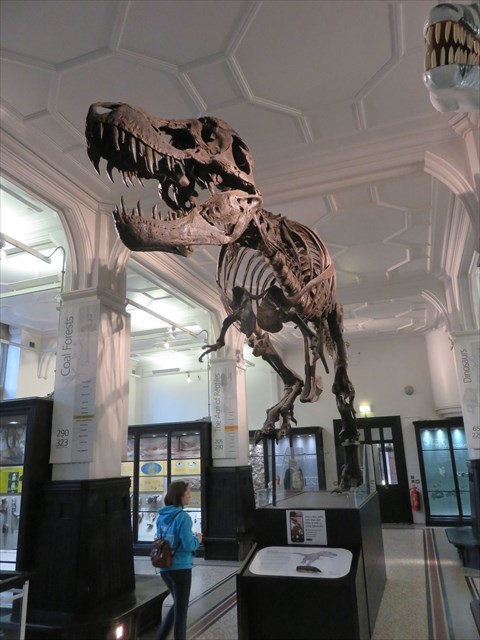
A fossil (from Classical Latin fossilis; literally, "obtained by digging") is any preserved remains, impression, or trace of any once-living thing from a past geological age. Examples include bones, shells, exoskeletons, stone imprints of animals or microbes, objects preserved in amber, hair, petrified wood, oil, coal, and DNA remnants. The totality of fossils is known as the fossil record.
Geologic time periods are what geologists and paleontologists use to organise the time flow of earths history. Because of the huge scope of time, 4.5 billion years, it is helpful to break it up into smaller chunks.
These divisions are not randomly assigned but they roughly correspond to changes in the geology, geography, climate and other characteristics of the earth. For the most part they follow the evolution of life or the lack of it, on earth.

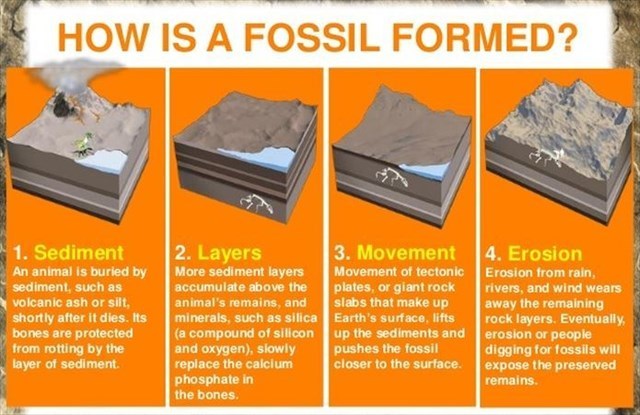
Living World
Moving on upstairs, you will come to the living worlds section. In this area there are displays of stuffed animals from various regions of the world. Moving through this area, you will see that one of the displays is dedicated to weather and contains samples of rocks containing fossils as well as a small bottle of crude oil and a lump of coal.
The beginning of crude oil formation happened hundreds of millions of years ago. Crude oil is a fossil fuel that has been formed from a large amount of marine organisms such as algae and zooplankton. These organisms fall to the bottom of the sea once they die and over time, get trapped under multiple layers of sand and mud.
As time goes by, heat and pressure began to rise as the organisms get buried deeper and deeper below the surface. Depending on the amount of pressure, heat and the type of organisms, determines if the organisms will become natural gas or oil. The more heat, the lighter the oil. If there is even more heat and the organisms were made up of mostly plants, then natural gas is formed. Gas is also formed by other processes such as in coal deposits.
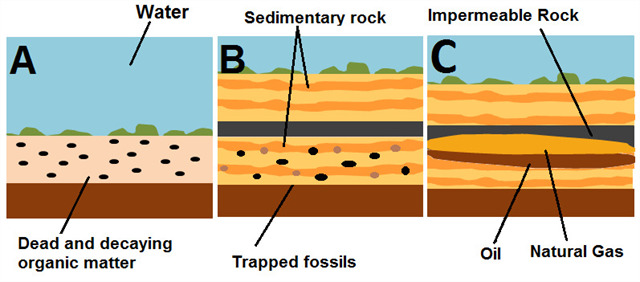
In the experience display you will see samples of rock of a wide variety of types. These include various crystalline structures as well as ores and pyrites.

Heading up the stairs to the left to the first balcony, you are able to get a good view of the whale skeleton suspended above the museum.
Nature's Library
Heading up the stairs to the left to the first balcony, you are able to get a good view of the whale skeleton suspended above the museum.
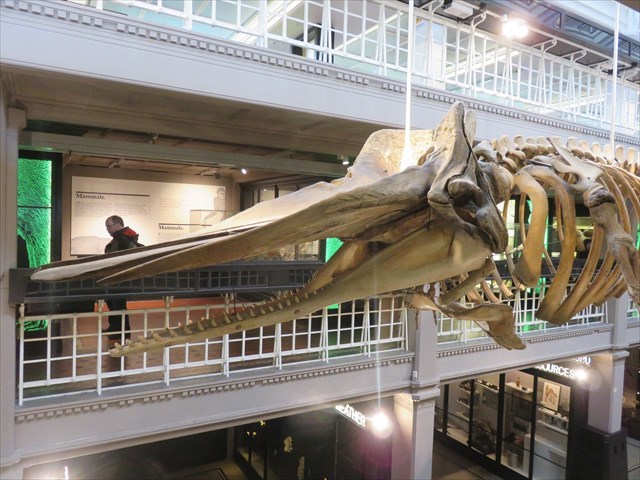
In the main display cabinets on this level, there are lots of samples of fossils from many geological periods, many of them containing superbly detailed fossils. Questions 7, 8 & 9 relate to this area

In addition to this, there are display cabinets containing samples of Agates. These samples are thin slices and show the detail found within these rocks.
Agate is a translucent variety of microcrystalline quartz. It is used as a semiprecious stone when it is of desirable quality and color. Agate generally forms by the deposition of silica from groundwater in the cavities of igneous rocks. The agate deposits in concentric layers around the walls of the cavity, or in horizontal layers building up from the bottom of the cavity. These structures produce the banded patterns that are characteristic of many agates.
Agate occurs in a wide range of colors, which include brown, white, red, gray, pink, black, and yellow. The colors are caused by impurities and occur as alternating bands within the agate. The different colors were produced as groundwaters of different compositions seeped into the cavity. The banding within a cavity is a record of water chemistry change. This banding gives many agates the interesting colors and patterns that make it a popular gemstone.
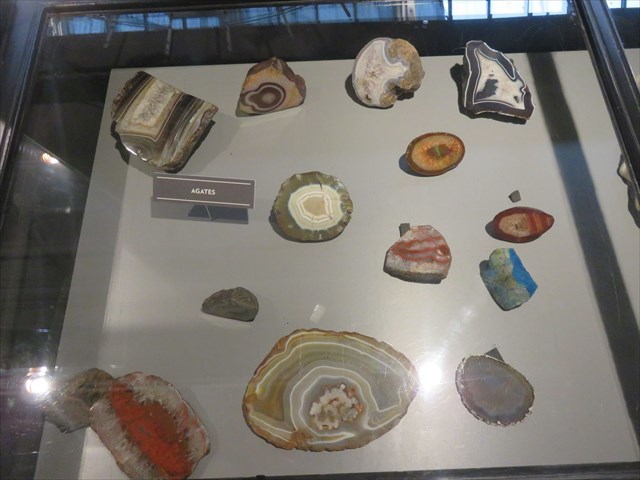
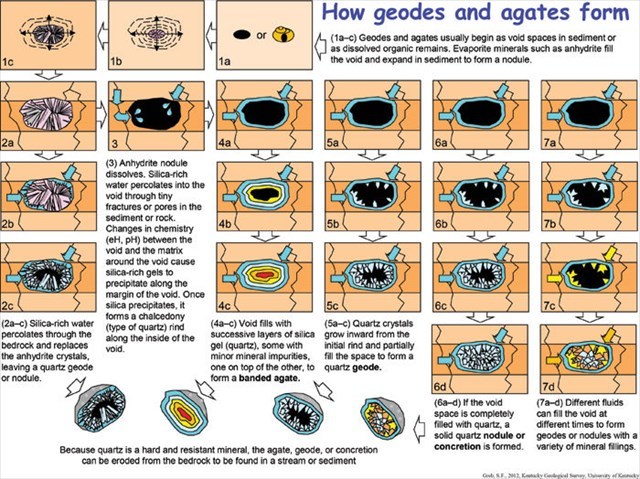
This area is the last stop on the EarthCache tour of the museum.
At the far end of this level, you will find the tropical realm with live exhibits of frogs, snakes and various other reptiles which is also worth a visit if you have the time whilst you are here. For visiting hours and a floorplan of the museum please visit
In order to log this Earthcache, send us the answers to the following questions via email or through the Message Center on our profile:
In the planets viewing area
1. Describe the texture of the Campo del Cielo meteorite. Is it rough or smooth? Why do you think this is?
2. Feel the three meteorite samples. Does the texture vary between the three? If so, how. How do the texture and colour compare to the Campo del Cielo meterorite?
In the Fossil Gallery:
3. In the Lower Carboniferous fossil display, what type of creature was sample number 64? What environment did this creature live in? What makes you think that? Which mythological character does it share it’s Latin name with?
4. Find the Cretaceous Sea Monster. Estimate the length of it's skull and the number of teeth visible in it's jaws
5. There is another fossil giant of the deep on display here. What's it's name? What type of rock was it found in? Why is this type of rock good for preserving fossils? Explain your answer
6. Do you think the T Rex skeleton is the original fossilised bones? Explain why you think that.
On the second floor in Nature's library:
7. Where did the crude oil in the bottle originate? In the fossil next to the bottle, what type of plant is this a fossil impression of?
8. In which era did reptiles swim in the seas and dinosaurs rule the land? How long ago was this? Give an example of a creature from that era from the relevant display.
9. What is the difference between an Agate and a Geode? Looking at the Agate display, which do you like most? Describe the colours and patterns in the Agate.
As an optional extra, post a photo of yourself or your GPS in front of the Tyrannosaurs Rex skeleton